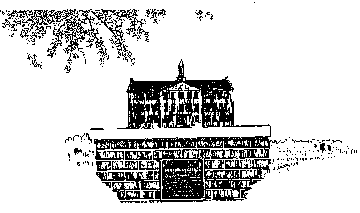Heritage Landmarks: Cokesbury College Site, Abingdon
A Traveler’s Guide to the Most Sacred Places in The United Methodist Church
Originally posted by the General Commission on Archives & History
» View the original article
» Download the PDF of all United Methodist Heritage Landmarks
 The idea of a Methodist academy in Abingdon, Maryland had been discussed as early as 1782. Thomas Coke (1747-1814) was John Wesley's envoy to American Methodists, making nine voyages to the United States. Coke and Francis Asbury (1745-1816) met at Barratt's Chapel in November 1784 and the following month Coke presided over the Christmas Conference at which the Methodist Episcopal denomination was formed.
The idea of a Methodist academy in Abingdon, Maryland had been discussed as early as 1782. Thomas Coke (1747-1814) was John Wesley's envoy to American Methodists, making nine voyages to the United States. Coke and Francis Asbury (1745-1816) met at Barratt's Chapel in November 1784 and the following month Coke presided over the Christmas Conference at which the Methodist Episcopal denomination was formed.
At their meeting at Barratt's Chapel, Coke and Asbury adopted the plan. The preachers at the Christmas Conference decided to name the school Cokesbury College in honor of their two bishops.
The school was founded to educate the sons of Methodist preachers, "poor orphans, and the sons of subscribers [financial supporters]." Cokesbury College opened on December 6, 1787, with an enrollment of 25 students and a faculty of three teachers.
According to a broadside dated September 15,
Academic instruction included English, Latin, Greek, Logic, Natural Philosophy, and Astronomy, but the major emphasis was on training students to be "rational scriptural Christians." In the midst of all his other duties, Asbury served the school as de facto president,
The college had a troubled history. On December 7, 1795, a fire, possibly set deliberately, destroyed the college building and its contents. After the fire, it was decided to move the college to Baltimore. A large building was purchased, and Cokesbury became an academy instead of a college. It enrolled some 200 students, but another fire just a year later, December 4, 1796, destroyed the college and any further plans of Coke and Asbury.
Despite its brief history, Cokesbury College has the distinction of being the first Methodist college on the American continent. It recalls for us Methodism's early commitment to education.
Points of interest at this Heritage Landmark: Cokesbury Memorial United Methodist Church stands near the site of the college. It was erected before the college and survived the 1795 fire.
The church cemetery contains granite markers which indicate the original corners of the college building. Also in the cemetery is a bronze model of the college on top of a monument to the college.
The cemetery is owned by the Cokesbury Memorial United Methodist Church. The lot and model are owned by the Baltimore United Methodist Historical Society.
Special events: On the first Sunday in June, the church commemorates Francis Asbury's laying of the cornerstone of the college.
Area attractions: Baltimore, with its many United Methodist-related historic places and other cultural attractions, is a short drive to the southwest. The Lovely Lane Museum (see address below) houses the Cokesbury College bell, which was replicated for the 1984 bicentennial of Methodism in America. Other Heritage Landmarks in this annual conference are Old Otterbein Church, the Robert Strawbridge House, and the Lovely Lane Meetinghouse Site.
To visit: Cokesbury Memorial United Methodist Church is open for regular worship on Sunday mornings. To tour the site at other times, contact Charles A. Riley (see address below).
Location: Within the boundaries of the Baltimore-Washington Annual Conference, in Harford County, northeast of Baltimore.
Food and lodging: Restaurants and lodging places are available in the Abingdon area.
Directions: Exit 4 from Interstate 95; go south on State Route 24 one mile, then northeast on State Route 7 for two miles. Turn right on Abingdon Road and proceed one block to the church.
For further information, contact: Charles A. Riley, c/o Cokesbury Memorial UM Church, 1304 Abingdon Road, Abingdon, MD 21009-1225; 410-676-6295; or E-mail: .
To learn more about United Methodist church history in this area:
- Lovely Lane Museum, 2200 St. Paul St., Baltimore, MD 21218; Arthur D. Thomas, Archivist.
- Frank Baker, From Wesley to Asbury: Studies in Early American Methodism (Durham, NC: Duke University Press, 1976).
- John Owen Gross, Cokesbury College (Nashville: Parthenon Press, 1955).
